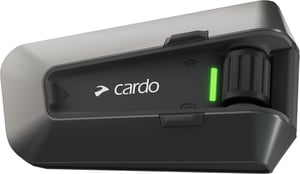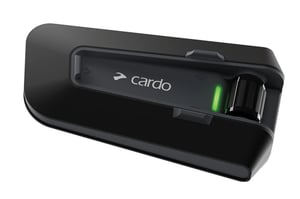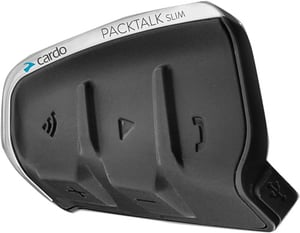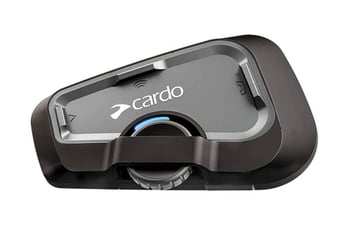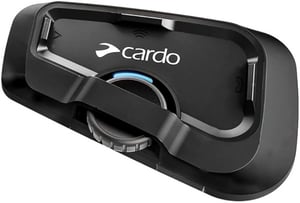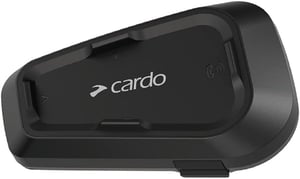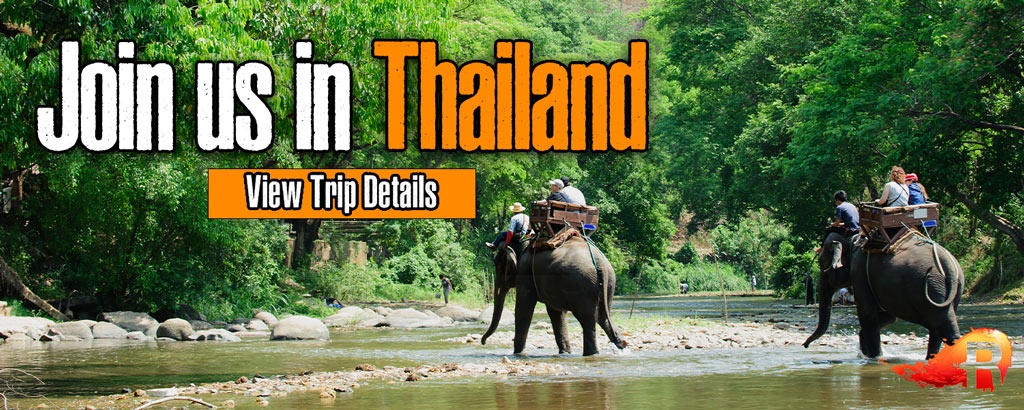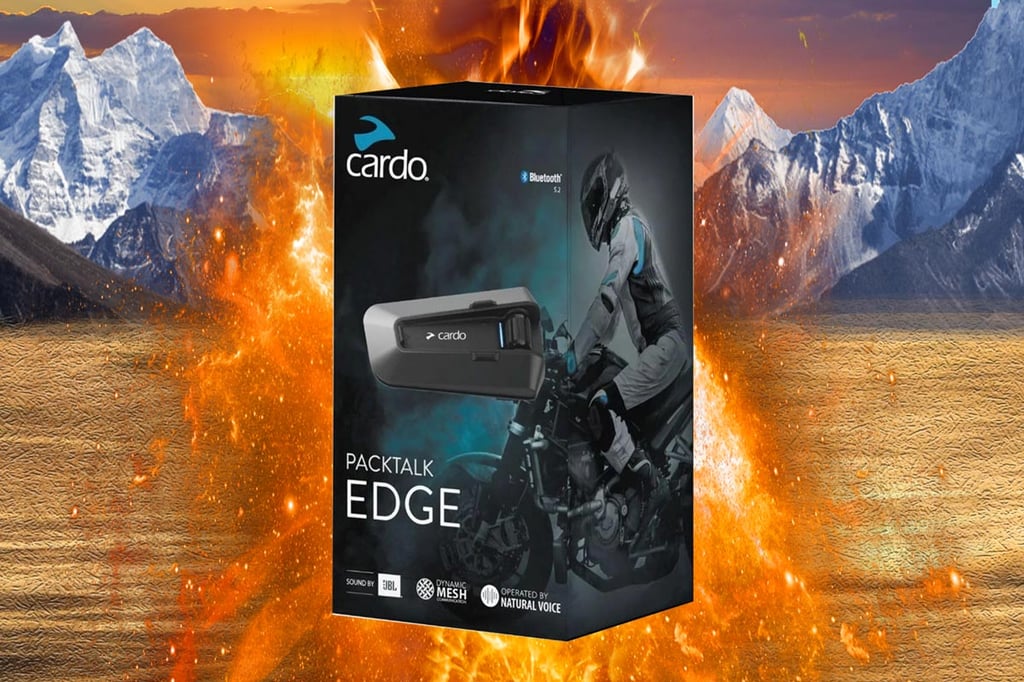
Disclosure: RIDE Adventures is a participant in the Amazon Services LLC Associates Program as well as other affiliate programs, designed to provide a means for us to earn fees by linking to Amazon and affiliated sites at no extra cost to you. Please see our Disclosure for more details.
Cardo's Packtalk leads the pack when it comes to helmet coms, and the Packtalk Edge is their latest flagship offering. Here's our take on the Edge after using and abusing it ourselves for the last year.
If you're adding Bluetooth to your helmet, nowadays the decision pretty much feels like "Cardo versus everything else." Cardo earned its reputation for pioneering Dynamic Mesh technology, adding name-brand speakers to their headsets, and pioneering reliable voice activation.
Other brands are slowly catching up, but if marketing materials are anything to be believed, the Packtalk Edge is simply the best helmet com money can buy today.
We've been fans of Cardo's Packtalk communicators for the better part of a decade, so naturally when this new Edge came to market, we jumped at the opportunity to test it out.
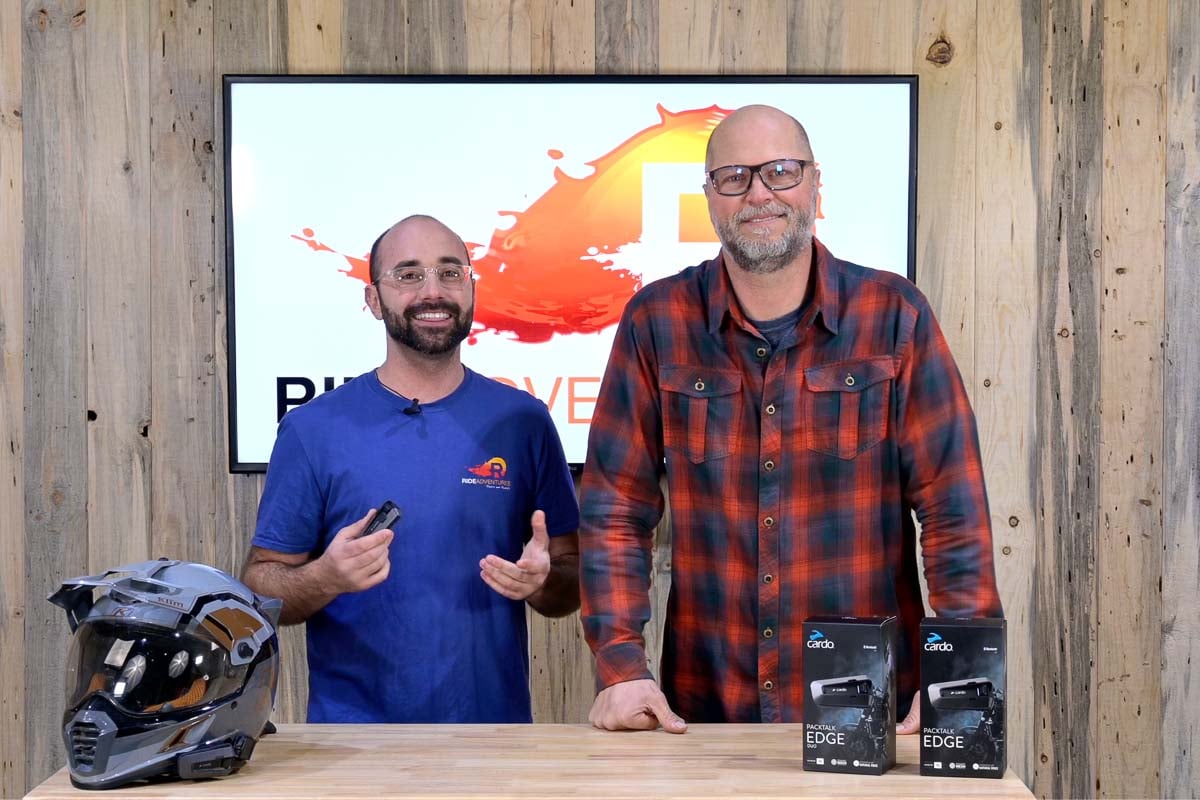
"Eric and Brandon reviewing the Packtalk Edge on our YouTube Channel."
We've been rocking the Packtalk Edge on our helmets for tens of thousands of miles at this point, and have used them everywhere from our home turf in Bend, OR to our international tours in places like Vietnam, Patagonia, and Baja California. Below we'll cover the highlights of Cardo's latest and greatest as well as a few of its shortcomings we'd like to see improved.
Before we jump into our impressions of the Edge, however, let's get a quick overview of the Packtalk lineup to review what alternatives are out there.
Why Choose the Cardo Packtalk Edge: Model Comparisons
Cardo's lineup of motorcycle communicators has never been larger or more confusing. By our count they've currently got eight different models to choose from, so to illustrate why the Packtalk Edge is our motorcycle helmet communicator of choice, here's a quick summary of the available models.
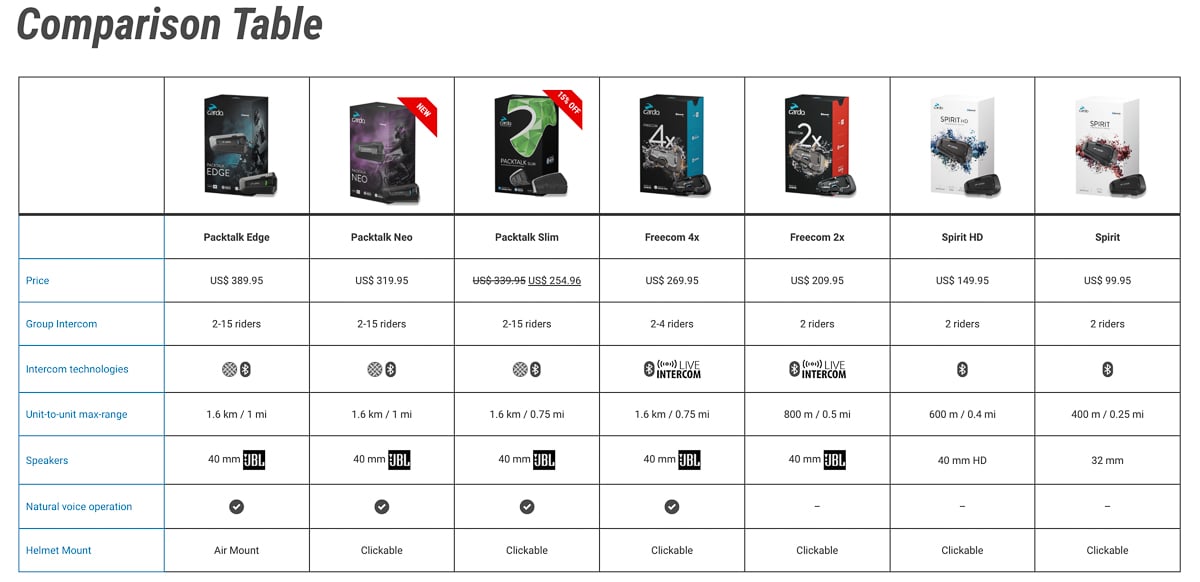
"Comparison sheet sourced via Cardo's website"
Cardo Packtalk Edge
The Packtalk Edge is Cardo's current flagship communicator, boasting the best of everything the company has to offer from range and battery life to features and mounting options.
The main headline with the Packtalk Edge is that it includes Cardo's latest version of Dynamic Mesh Communication, which allows up to 15 riders to easily connect and chat. Dynamic Mesh also includes an auto-healing feature that automatically lets riders join and leave the group as they drift in and out of coverage area.
The Edge is also the only option in the Cardo lineup to feature their convenient new magnetic "air mount" system, which is fast, easy, and completely secure in our experience.
Check Price:
Cardo Packtalk Neo
The Palktalk Neo is essentially a carbon-copy of the Packtalk Edge that includes all the same tech, features, and performance, but costs about $40 less. Functionally the two units are identical (range, battery life, group size, etc.), with two notable exceptions.
The first is that the Neo uses a standard clip-in mount rather than the nifty magnetic "Air Mount" of the Edge.
The second is that the Neo gets a reduced two-year warranty compared to the Edge's three-year coverage, although seeing as how the two units are otherwise identical, there shouldn't be any difference in build quality between the two.
Check Price:
Cardo Packtalk Slim
The Packtalk Slim is the third "premium" offering in the Cardo lineup, offering the same features and performance as the Edge and the Neo, albeit in a slimmer overall package that hides the majority of its bulk (the battery) at the rear of the helmet. The Packtalk Slim is also a bit cheaper than the flagship Edge unit, but again, it comes with a few minor tradeoffs.
The first is that the single rider-to-rider range is slightly reduced from 1 mile to roughly .75 miles. The second is that once the Slim is mounted to your helmet, the most convenient way to charge it to to bring your entire helmet to a power source, unlike the Edge and Neo which can be easily disconnected and charged anywhere.
(Note: it seems Cardo may be discontinuing this unit in the near future, as it's currently on sale at a significant discount on their site and no longer carried by most major suppliers.)
Check Price:
Cardo Packtalk Freecom 4X
The Freecom 4X is the first "budget-focused" helmet com in the Cardo lineup, coming in at over $100 less than the Cardo Packtalk Edge. It's a great deal for the money, but there are a few more significant tradeoffs here you'll want to be familiar with.
The main difference is that the Freecom doesn't get Cardo's silky-smooth Dynamic Mesh connection tech, and instead relies on a Bluetooth "Live Intercom" system.
This system includes an auto-reconnect feature, but only supports up to four riders and doesn't get the range-boosting benefits of Dynamic Mesh.
The Freecom also gets a slightly less user-friendly interface (in our opinion), reduced rider-to-rider range of .75 miles, and a standard click-in mount.
Check Price:
Cardo Packtalk Freecom 2X
The Freecom 2X is nearly identical to the 4X in terms of tech, style, and features, but reduces the maximum group size to just 2 riders and the maximum rider-to-rider range to .5 miles.
You're still getting the same great JBL audio quality and Bluetooth Live Intercom connectivity, however, so for riders who only need to chat with one other person (your riding buddy or, more likely, your passenger), it's a quality helmet com that nails the basics.
The Freecom 2X is also much more affordable than anything previously mentioned with a starting MSRP of just $210.
Check Price:
Cardo Spirit and Spirit HD
Cardo's "Sprit" line of helmet coms are their bare-bones, no-frills offerings, delivering the lowest asking price of any of the Cardo units for folks who just need basic two-way communications.
The Freecom's Live Intercom technology is replaced with a standard Bluetooth connection, while the range is reduced to .4 miles in the Spirit HD and just .25 miles in the Spirit.
These coms are most well suited for basic rider-to-passenger intercom use, but they work well enough for you and a friend, provided you can keep pace with one another.
The Spirit systems are also the only Cardo offerings that come without 40mm JBL speakers, as the Spirit HD uses an unbranded 40mm "HD" speaker, while the base model Spirit uses even simpler 32mm speakers.
Check Price:
Cardo Packtalk Edge Review: The Good and the Bad
Alright, let's dive into the nitty-gritty. Here's our firsthand take on the Packtalk Edge after a year on the road.
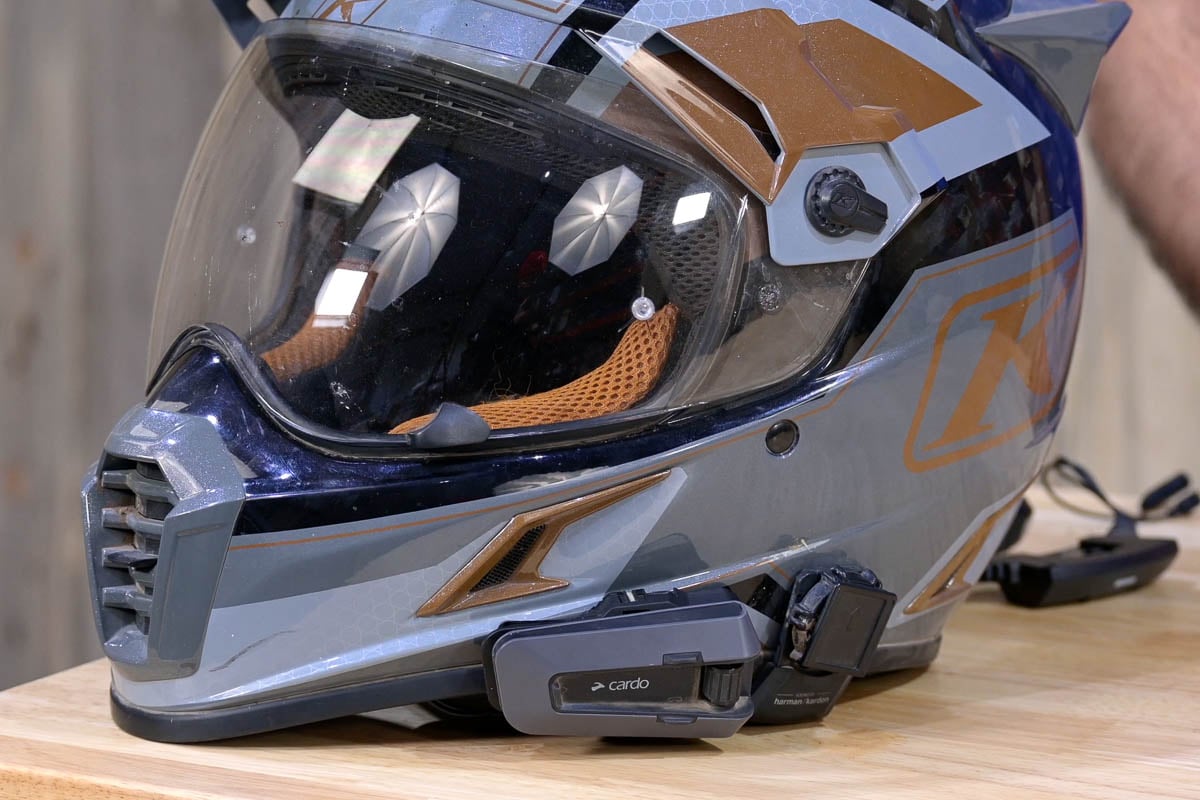
Cardo Packtalk Edge Spec Review:
- Range: Up to 5 miles
- Battery Life: 13 hours talk time (10 days stand-by)
- Connection Type: Bluetooth 5.2 with Dynamic Mesh
- Weatherproofing: IP67
- Max Group Size: 15
- Speakers: 40mm JBL Audio
Cardo Packtalk Edge: The Good
- Best in class rider to rider range
- Best in class overall range
- Seamless Dynamic Mesh connection
- Premium JBL 40mm sound
- Impressive 15 rider max
- Convenient magnetic "air mount"
Everyone's first concern with any helmet communicator is range, so we'll start there. Our general impression with the Edge is that it's easily among the best we've used, especially when leveraging the Dynamic Mesh technology in groups of 3+ for an extra signal boost.
For rider-to-rider performance, we found the Edge reliable to about 3/4 mile in ideal conditions (open road, mostly straight), while on curvy mountain roads and canyons, we'd typically get about a half mile between riders.
The Dynamic Mesh's signal boost works as advertised, and while you'll never actually see 15 miles of range in a group of 15 people, the rider at the front should always be able to speak with the rider at the rear, given the distance between any two consecutive riders in the group never exceeds half a mile.
 "The Packtalk Edge will have the best reach in conditions like these."
"The Packtalk Edge will have the best reach in conditions like these."
As for audio, Cardo's 40mm JBL speakers continue to deliver best in class sound out of all the helmet coms we've used over the years. We also appreciate that the Cardo smartphone app allows you to choose custom audio profiles to favor voice clarity, bass, or volume.
As for the headline feature of the Cardo Packtalk Edge, the magnetic Air Mount system: This is a sweet little novelty we've enjoyed using over the last several months.
While it's by no means necessary, we've found it's just as secure as Cardo's standard click in mount while being much easier and more convenient to use.
 "Our team of guides have used the Packtalk Edge on tour for the past 3 years and are happy to report that none have failed to withstand the elements."
"Our team of guides have used the Packtalk Edge on tour for the past 3 years and are happy to report that none have failed to withstand the elements."
Apart from that, our favorite feature of the Edge is reliability. That IP67 rating means it's completely sealed from both water and dust, and we've had no issues with either element.
The Edge is also backed by the most robust warranty Cardo offers at a three full years, which helps justify its higher asking price.
Cardo Packtalk Edge: The Bad
- Most expensive Cardo option
- Range is highly dependent on terrain
- Bulky
- Less expensive alternatives
Speaking of price, our biggest gripe with the Packtalk Edge is cost, especially considering there are so many similar alternatives in Cardo's own line of helmet coms for a lot less cash.
The Packtalk Neo is particularly attractive in this regard, offering all the same features minus the magnetic mounting plate for a whopping $70 less.
Riders who have no need to talk with more than 3 friends at once stand to save even more by opting for the $270 Freecom 4X, although the lack of Dynamic Mesh's signal boosting tech will likely result in spottier communication on twistier roads.

Speaking of which, we also noted that the Dynamic Mesh makes zero difference when riding offroad in wooded/mountainous conditions. While riding through some of the tighter off-road sections of the Appalachian Mountains, we found our connection would regularly drop anywhere further than line of sight, which means the lead rider often can't warn followers of oncoming traffic or difficult obstacles, while riders in the rear can't report crashes or issues should they need help from the group ahead.
Of course as of this writing this is a common feature on all helmet communicators, which is why two-way radios are still the best tool for the job in the backcountry. The Cardo Packtalk Edge still works well enough on wider sections of mountain gravel roads, but once things get sketchy, it struggles to find its footing.
The only other minor complaint we have with the Edge is that it still makes for a fairly bulky obtrusion on the side of our helmets. It's a small inconvenience at best, but something we're constantly bumping into just the same.
Is the Cardo Packtalk Edge for You?
The goal of our Cardo Packtalk Edge review is to give you an idea of who actually needs all of Cardo's bells and whistles. For folks like us, who constantly ride with large groups of riders we need to keep connected by any means necessary, this one is a no-brainer.
 If you want the latest and greatest and have the cash to spend, we're convinced this is hands-down the best Bluetooth helmet com on the market. If you don't care about the handy magnetic mounting system and prefer to save a few bucks, the Packtalk Neo will likely deliver more bang for your buck.
If you want the latest and greatest and have the cash to spend, we're convinced this is hands-down the best Bluetooth helmet com on the market. If you don't care about the handy magnetic mounting system and prefer to save a few bucks, the Packtalk Neo will likely deliver more bang for your buck.
We'll also note that if you're riding solo, with a smaller group, or with just a passenger, the range and convenience benefits of Dynamic Mesh may not be worth the cost of entry, making the Freecom 4X a particularly sweet option.
Check Price:
We'll also note that while we didn't address Cardo's latest "Packtalk Custom" system, you should just skip that option entirely as a monthly subscription plan for a helmet communicator is just ridiculous and reeks of corporate cash-grab.
→Read More: Parking a Motorcycle: 6 Rookie Mistakes and Street & ADV Motorcycle Training.



